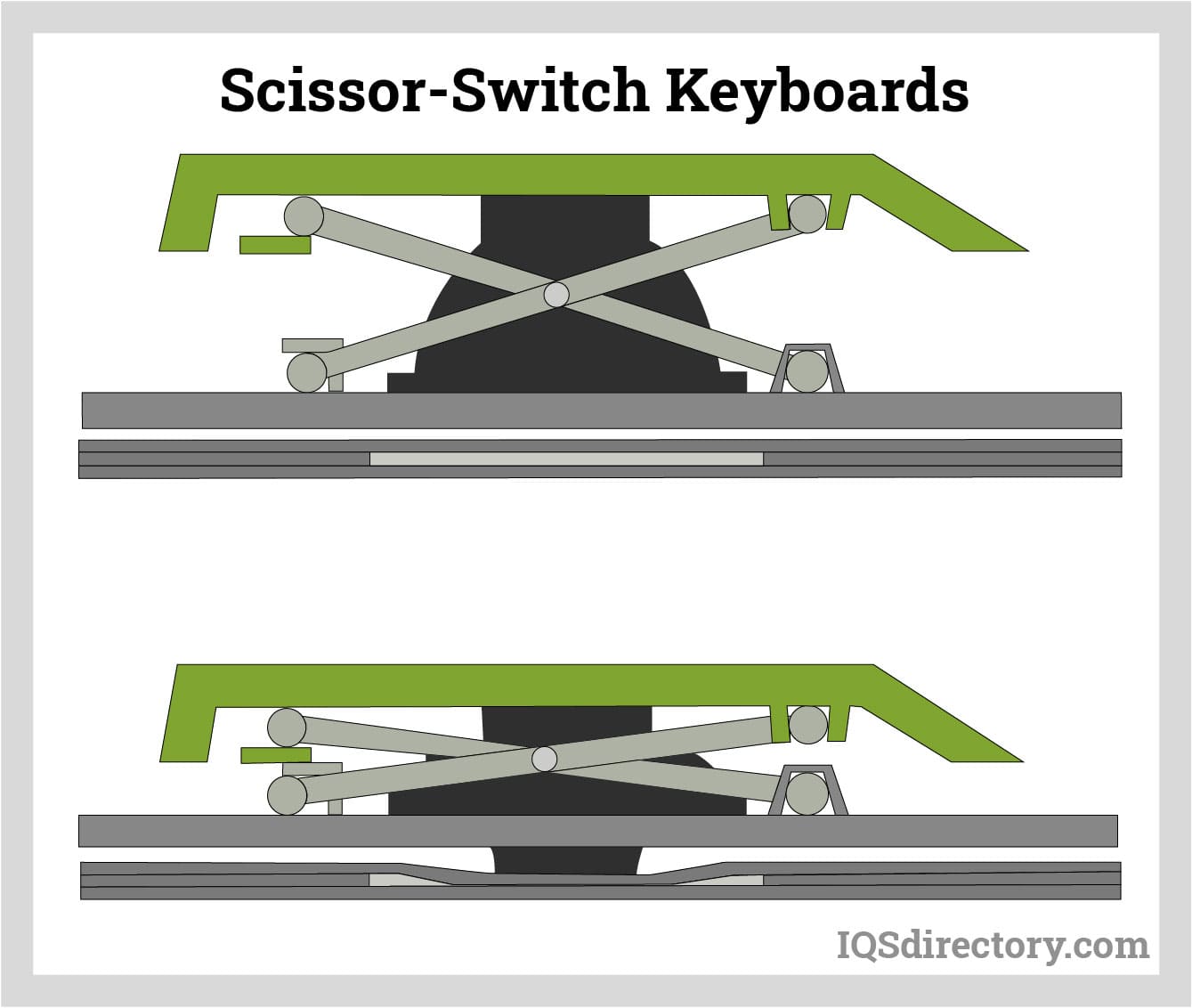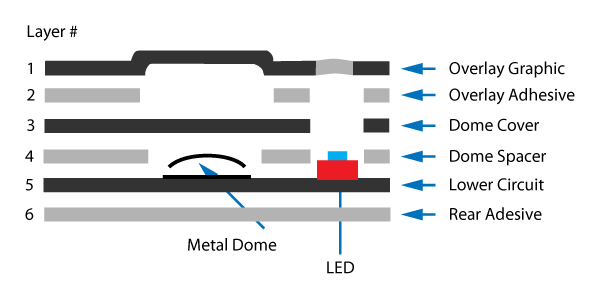Everything About Membrane layer Change: A Comprehensive Overview for Beginners
Membrane buttons are crucial parts in modern electronic devices, providing a distinct user interface for individual communication - membrane switch. Their layered building and construction, including overlays and conductive traces, gives performance and resilience. Unlike traditional mechanical switches, membrane layer buttons present a smooth design and adjustable options. Comprehending their key functions and advantages can transform item design. The complexities of their application and layout factors to consider require more expedition.
What Is a Membrane Switch?
A membrane button is a kind of electrical switch that contains an adaptable membrane layer layered over a printed circuit card. This layout enables a sleek and small interface, typically made use of in numerous electronic devices. Membrane switches are frequently located in customer appliances, clinical equipment, and commercial equipment as a result of their durability and resistance to ecological factors.The construction usually consists of numerous layers, such as visuals overlays and glue support, which provide tactile feedback and protect the circuitry underneath. The operation of a membrane switch is initiated when pressure is related to the surface area, finishing an electric circuit.These buttons are valued for their convenience, making it possible for personalized layouts and published graphics that accommodate certain interface. Their inconspicuous nature minimizes area requirements, making them perfect for applications where conventional switches may not fit. On the whole, membrane layer buttons provide a practical and aesthetic option for modern-day digital gadgets.
Secret Components of Membrane Layer Switches Over
Membrane switches consist of a number of essential components that add to their performance and performance. The leading layer, understood as the overlay, offers the interface and is often published with graphics or signs. Under the overlay exists a spacer layer, which separates the conductive components and stops inadvertent activation. The following important component is the visuals layer, which improves aesthetics and ensures the durability of the design.Conductive traces, typically made from products like silver or carbon, are printed on the circuit layer. When stress is put on the overlay, these traces come right into contact, finishing the circuit. Additionally, a support layer provides architectural support and can be made from products such as polyester or polycarbonate. Together, these elements develop a reputable, user-friendly interface ideal for different applications, from house appliances to commercial equipment. Comprehending these components is vital for any person thinking about membrane layer switch innovation.
Just How Membrane Layer Changes Job
Recognizing how membrane layer switches over feature is vital for valuing their prevalent use in different gadgets. A membrane layer button operates with a collection of layers, consisting of a visuals overlay, spacer, and a circuit layer. When pressure is put on the overlay, it compresses the spacer layer, enabling the circuit layer to make call and finish an electric circuit. This action sends a signal to the gadget, triggering a feedback, such as activating a light or activating a function.Membrane switches can be developed with different attributes, consisting of responsive comments, backlighting, and personalized graphics, boosting user interaction. Their construction enables for a closed style, safeguarding the interior components from dirt, moisture, and contaminants. This sturdiness makes them appropriate for varied applications, from customer electronic devices to industrial devices. In general, the simplicity and efficiency of membrane switches add to their appeal in modern-day innovation.
Benefits of Membrane Switches Mechanical Switches
While mechanical buttons have actually long been a staple in lots of gadgets, membrane switches deal distinctive benefits that make them progressively appealing. One considerable benefit is their slim account, permitting for even more small designs and better versatility in product development. In addition, membrane switches over attribute an uniform surface, which boosts visual appeal and streamlines cleansing, making them suitable for settings where health is critical.Another advantage is their resistance to dirt and wetness. Unlike mechanical switches, which can be endangered by environmental factors, membrane layer switches provide a covered interface that protects versus contaminants - membrane switch. Moreover, membrane layer switches normally have a longer life expectancy as a result of fewer relocating components, resulting in improved resilience and reliability.Cost-effectiveness is additionally a significant advantage, as membrane layer buttons can be created wholesale with lower production costs. These factors integrate to place membrane switches as a functional alternative to conventional mechanical alternatives in various applications
Typical Applications of Membrane Layer Switches
Membrane switches are extensively used in different markets, specifically in consumer electronics and commercial control board. In customer devices, they offer a smooth, straightforward interface, while in industrial settings, they improve longevity and functionality. Understanding these applications highlights the adaptability and usefulness of membrane layer buttons in modern technology.
Consumer Electronics Gadgets
As consumer electronics continue to develop, membrane switches have ended up being a prominent option for a selection of tools as a result of their convenience and streamlined layout. These buttons are commonly located in smart devices, tablets, and remote controls, where space is limited and looks issue. Their reduced profile and adjustable styles allow manufacturers to create user-friendly interfaces that boost the total customer experience. Furthermore, membrane switches are often used in devices such as microwaves and coffee manufacturers, supplying user-friendly control choices while resisting dampness and dust. The toughness and dependability of membrane switches over make them appropriate for daily consumer items, making sure durability and consistent efficiency. Generally, their integration in customer electronic devices reflects a mix of performance and modern layout.
Industrial Control Panels
The applications of membrane switches over prolong beyond customer electronics, locating significant usage in industrial control board. These switches are preferred for their toughness and resistance to severe settings, making them suitable for manufacturing and procedure control settings. They give a reputable interface official site for operators to regulate machinery, display processes, and readjust settings. Membrane buttons can be customized to match specific functional demands, integrating features like backlighting and tactile feedback, enhancing individual experience. Their inconspicuous design permits integration into numerous equipment, while their capability to withstand spills, dust, and severe temperature levels assurances long life. Overall, membrane buttons add to efficient and risk-free operation in industrial applications, showing their versatility and effectiveness in requiring settings.
Factors To Consider for Designing Membrane Changes
When making membrane switches, selecting the best materials is necessary to guarantee resilience and performance. In addition, recognizing layer configuration techniques can significantly impact the switch's performance and individual experience. These considerations play a crucial function in producing efficient and trusted membrane layer button layouts.
Material Choice Value
Material choice plays a necessary function in the style and performance of membrane switches. The picked products straight affect the switch's durability, tactile response, and total visual. Secret considerations include the substratum, which need to supply structural integrity while enabling flexibility, and the visuals overlay, which requires to be resistant to wear and ecological aspects. Conductive materials need to assure trusted electric performance, while adhesives have to supply strong bonding without compromising the button's procedure. Additionally, compatibility with making procedures and end-user environments is essential; products must withstand differing temperatures, moisture levels, and chemical direct exposure. Eventually, suitable product choice not just improves the membrane layer switch's efficiency however also adds to its longevity and customer complete satisfaction, making it a crucial facet of the design procedure.

Layer Configuration Methods

Frequently Asked Inquiries
How Much Time Do Membrane Layer Changes Commonly Last?
Membrane buttons usually have a life expectancy of 1 to 5 million cycles, relying on usage and environmental problems. Factors such as style top quality and operating frequency significantly affect their resilience and general efficiency longevity.

Can Membrane Switches Be Customized for Details Styles?
Membrane switches can without a doubt be tailored to fit specific layouts, permitting diverse forms, shades, and performances. This versatility makes it possible for makers to tailor these buttons to satisfy distinct visual and operational requirements properly.
What Materials Are Used in Membrane Layer Switch Over Building?
Membrane buttons are usually constructed utilizing materials such as polyester, polycarbonate, and glue layers. These materials give toughness, resistance, and flexibility to ecological variables, guaranteeing the switches operate effectively in different applications and problems.
Are Membrane Layer Switches Over Immune or waterproof to Moisture?
Membrane switches can be created to be moisture-resistant, making use of specialized materials and finishes. Their waterproof capabilities depend on construction quality and particular applications, making it important to evaluate requirements for perfect performance in various environments.
How Are Membrane Layer Switches Over Fixed if Harmed?
Repairing damaged membrane layer switches typically involves changing the influenced layer or circuit. Service technicians might likewise apply conductive glue or make use of specialized repair service sets, guaranteeing functionality is restored without full replacement of the entire button setting up. Unlike conventional mechanical switches, membrane next page layer switches present a sleek layout and adjustable options. A membrane layer button is a type of electric switch that consists of an adaptable membrane layered over a published circuit board. The procedure of a membrane button is initiated when stress is used to the surface, finishing an electrical circuit.These buttons are valued for their flexibility, enabling personalized styles and published graphics that cater to details individual interfaces. While mechanical switches have actually long been a staple in many tools, membrane changes offer unique advantages that make them progressively appealing. Membrane switches typically have a longer life expectancy due to less moving components, resulting in enhanced longevity and reliability.Cost-effectiveness is likewise a remarkable benefit, Continue as membrane layer switches can be created in mass with lower production prices.